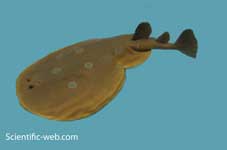The common torpedo, Torpedo torpedo, is a species of electric ray in the family Torpedinidae. It is also known as the eyed electric ray or the ocellated electric ray, for the distinctive blue spots on its back.[1] The common torpedo is capable of generating an electric shock of up to 45 volts. Its electrogenic properties have been known since ancient times, and it was used to treat pain by the Romans.[2] The common torpedo is found in the Mediterranean Sea and the eastern Atlantic Ocean from the Bay of Biscay to Angola.[1] There is a single record from northern Europe, though it was likely erroneous. This species is the rarest of the European electric rays and occurs infrequently north of the Mediterranean. [3] It is usually found on or half-buried in sand or amongst seagrass beds to a depth of 70 m, though it is occasionally reported as deep as 400 m.[1][4] Description Like other Torpedo species, the common torpedo has a circular pectoral fin disc containing two large electric organs. The tail is short and fat, with two dorsal fins and a well-developed caudal fin. The spiracles are wider than the eyes, with a smooth or slightly fringed margin. The skin is smooth, without dermal denticles. The coloration is light to dark brown above and off-white below; there are 5 (occasionally 1, 3, or 7) prominent blue spots (or ocellae) on the back, surrounded by black and light brown rings.[4] A male with 8 ocellae is known from Tunisia, and an unusual adult male with 9 ocellae has been caught off Languedoc in southern France. In individuals with more than 5-6 ocellae, the additional spots tend to be smaller and placed further towards the head.[5] There is also a record of an adult albino female captured off northern Tunisia.[6] It grows up to 60 cm long.[4] Biology and ecology Adult common torpedoes are solitary, nocturnal hunters that feed mostly on fishes and crustaceans.[4] The juveniles are less specific and take a variety of prey items. Like other electric rays, the common torpedo is ovoviviparous, with an annual breeding cycle. Individuals segregate by sex during the breeding period, when gravid females enter shallower coastal waters. In the Mediterranean, mating takes place between December and February, ovulation in March and April, and parturition in late August and September after a gestation period of 5-6 months. The litter size ranges from 1-9, and is correlated with the size of the female. Young average 7.3 cm long at birth; males and females mature at 18 cm and 22 cm respectively off Egypt, and 24.9 cm and 25.8 cm respectively off Latium. Off the coast of Senegal, common torpedoes attain larger sizes and have heavier eggs and longer gestation periods of 6-8 months. The litter sizes range from 5-28, and the young range from 10-12.5 cm long at birth.[7][8][9] Relationship to humans Before the invention of technology to produce and store electricity in the 19th century, the common torpedo and other electric fishes were used in medicine. The Roman physician Scribonius Largus recommended the use of live torpedo fish (Torpedo torpedo) for the treatment of pain in his Compositiones medicae (c. 50 A.D.). For chronic headaches, the fish was to be placed on the affected spot until the pain ceased.[10] References 1. ^ a b c "Torpedo torpedo". FishBase. Ed. Ranier Froese and Daniel Pauly. November 2008 version. N.p.: FishBase, 2008.
Retrieved from "http://en.wikipedia.org/" |
|

